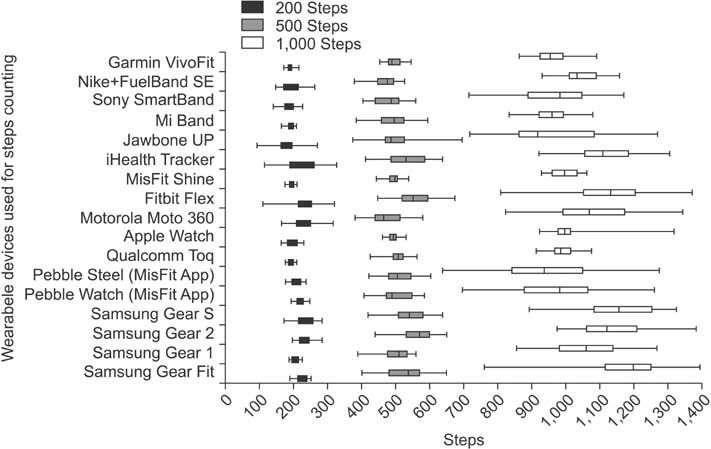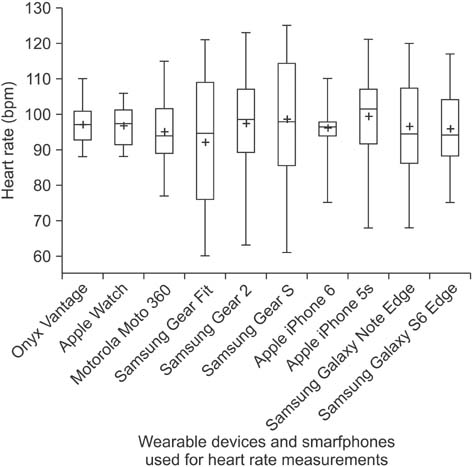Healthc Inform Res.
2015 Oct;21(4):315-320. 10.4258/hir.2015.21.4.315.
Are Currently Available Wearable Devices for Activity Tracking and Heart Rate Monitoring Accurate, Precise, and Medically Beneficial?
- Affiliations
-
- 1Department of Pharmaceutics, Faculty of Pharmacy, Alexandria University, Alexandria, Egypt. mohamed.nounou@alexu.edu.eg
- 2Department of Pharmaceutical Sciences, Appalachian College of Pharmacy, Oakwood, VA, USA.
- KMID: 2166882
- DOI: http://doi.org/10.4258/hir.2015.21.4.315
Abstract
OBJECTIVES
The new wave of wireless technologies, fitness trackers, and body sensor devices can have great impact on healthcare systems and the quality of life. However, there have not been enough studies to prove the accuracy and precision of these trackers. The objective of this study was to evaluate the accuracy, precision, and overall performance of seventeen wearable devices currently available compared with direct observation of step counts and heart rate monitoring.
METHODS
Each participant in this study used three accelerometers at a time, running the three corresponding applications of each tracker on an Android or iOS device simultaneously. Each participant was instructed to walk 200, 500, and 1,000 steps. Each set was repeated 40 times. Data was recorded after each trial, and the mean step count, standard deviation, accuracy, and precision were estimated for each tracker. Heart rate was measured by all trackers (if applicable), which support heart rate monitoring, and compared to a positive control, the Onyx Vantage 9590 professional clinical pulse oximeter.
RESULTS
The accuracy of the tested products ranged between 79.8% and 99.1%, while the coefficient of variation (precision) ranged between 4% and 17.5%. MisFit Shine showed the highest accuracy and precision (along with Qualcomm Toq), while Samsung Gear 2 showed the lowest accuracy, and Jawbone UP showed the lowest precision. However, Xiaomi Mi band showed the best package compared to its price.
CONCLUSIONS
The accuracy and precision of the selected fitness trackers are reasonable and can indicate the average level of activity and thus average energy expenditure.
Keyword
MeSH Terms
Figure
Cited by 3 articles
-
Evaluation of the IngVaL Pedobarography System for Monitoring of Walking Speed
Per Anders Rickard Hellstrom, Anna Åkerberg, Martin Ekström, Mia Folke
Healthc Inform Res. 2018;24(2):118-124. doi: 10.4258/hir.2018.24.2.118.Simple Wearable Device to Reduce Stress When Delivering a Speech without Pre-training
Takahiro Yamane, Yuma Nakadoi, Mina Takagi, Mizuki Morita
Healthc Inform Res. 2021;27(3):231-240. doi: 10.4258/hir.2021.27.3.231.Validation of Wearable Digital Devices for Heart Rate Measurement During Exercise Test in Patients With Coronary Artery Disease
Chul Kim, Jun Hyeong Song, Seung Hyoun Kim
Ann Rehabil Med. 2023;47(4):261-271. doi: 10.5535/arm.23019.
Reference
-
1. McGrath MJ, Scanaill CN. Wellness, fitness, and lifestyle sensing application. In : McGrath MJ, Scanaill CN, editors. Sensor technologies: healthcare, wellness, and environmental application. New York (NY): Apress Media;2013. p. 217–248.2. Alger K. Wearable technology is revolutionizing fitness [Internet]. London: Raconteur;2014. cited at 2015 Oct 1. Available from: http://raconteur.net/technology/wearables-are-the-perfect-fit.3. Jeon E, Park HA. Factors affecting acceptance of smartphone application for management of obesity. Healthc Inform Res. 2015; 21(2):74–82.
Article4. Jeon E, Park HA. Development of a smartphone application for clinical-guideline-based obesity management. Healthc Inform Res. 2015; 21(1):10–20.
Article5. Wagenaar RC, Sapir I, Zhang Y, Markovic S, Vaina LM, Little TD. Continuous monitoring of functional activities using wearable, wireless gyroscope and accelerometer technology. Conf Proc IEEE Eng Med Biol Soc. 2011; 2011:4844–4847.
Article6. Yilmaz T, Foster R, Hao Y. Detecting vital signs with wearable wireless sensors. Sensors. 2010; 10(12):10837–10862.
Article7. Prisacariu VA, Reid I. 3D hand tracking for human computer interaction. Image Vis Comput. 2012; 30(3):236–250.
Article8. Duffy J. Best fitness trackers for 2015 [Internet]. New York (NY): pcmag.com;2015. cited at 2015 Oct 1. Available from: http://www.pcmag.com/article2/0,2817,2404445,00.asp.9. Profis S. Do wristband heart trackers actually work? A checkup [Internet]. San Francisco (CA): CNET;2014. cited at 2015 Oct 1. Available from: http://www.cnet.com/news/how-accurate-are-wristband-heart-rate-monitors/.10. Stein S. Garmin Vivofit review: long battery life in a fitness band, no charger needed [Internet]. San Francisco (CA): CNET;2014. cited at 2015 Oct 1. Available from: http://www.cnet.com/products/garmin-vivofit/.11. Garmin Connect Mobile application [Internet]. Mountain View (CA): Google Play;2014. cited at 2015 Oct 1. Available from: https://play.google.com/store/apps/details?id=com.garmin.android.apps.connectmobile&hl=en.12. Poh MZ, McDuff DJ, Picard RW. Non-contact, automated cardiac pulse measurements using video imaging and blind source separation. Opt Express. 2010; 18(10):10762–10774.
Article13. Chan M, Esteve D, Fourniols JY, Escriba C, Campo E. Smart wearable systems: current status and future challenges. Artif Intell Med. 2012; 56(3):137–156.
Article14. Darwish A, Hassanien AE. Wearable and implantable wireless sensor network solutions for healthcare monitoring. Sensors (Basel). 2011; 11(6):5561–5595.
Article15. Patel MS, Asch DA, Volpp KG. Wearable devices as facilitators, not drivers, of health behavior change. JAMA. 2015; 313(5):459–460.
Article16. Bravata DM, Smith-Spangler C, Sundaram V, Gienger AL, Lin N, Lewis R, et al. Using pedometers to increase physical activity and improve health: a systematic review. JAMA. 2007; 298(19):2296–2304.
Article17. Case MA, Burwick HA, Volpp KG, Patel MS. Accuracy of smartphone applications and wearable devices for tracking physical activity data. JAMA. 2015; 313(6):625–626.
Article18. Taylor B. 26 Fitness trackers ranked from worst to first [Internet]. New York (NY): Time Inc.;2014. cited at 2015 Oct 1. Available from: http://time.com/516/26-fitness-trackers-ranked-from-worst-to-first/.
- Full Text Links
- Actions
-
Cited
- CITED
-
- Close
- Share
- Similar articles
-
- Introduction of Wearable Device in Cardiovascular Field for Monitoring Arrhythmia
- Can Fitness Trackers Track Sleep?
- Wearable Devices in Medical Internet of Things: Scientific Research and Commercially Available Devices
- Perspective on Wearable Devices for Cardiac Arrhythmia Detection
- Non-EEG Seizure Detection Using Wearable Device



